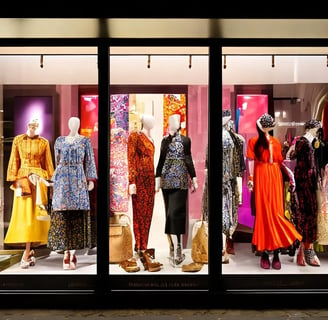Global Fashion Trends: Striking Elements Shaping the Industry
FASHION
Hakan Kemal
7/23/20242 min read


Introduction
The fashion industry is a dynamic and ever-evolving landscape where trends come and go, but certain elements leave a lasting impact. In the global arena, fashion trends are influenced by a myriad of factors including cultural shifts, technological advancements, and socio-economic changes. This article explores some of the most striking elements currently shaping the international fashion world, highlighting how these trends reflect and respond to our changing times.
1. Sustainable and Ethical Fashion
One of the most significant trends in the global fashion industry is the shift towards sustainability and ethical practices. Consumers are increasingly demanding transparency and accountability from brands regarding their environmental and social impacts. This has led to a rise in eco-friendly materials, ethical production processes, and circular fashion models where recycling and upcycling are key. Brands like Stella McCartney and Patagonia are at the forefront of this movement, setting new standards for what it means to be a responsible fashion brand.
2. Tech-Integrated Fashion
Technology is revolutionizing fashion in unprecedented ways. From smart fabrics that monitor health metrics to augmented reality (AR) fitting rooms, the integration of tech into fashion is a major trend. Wearable technology, such as smartwatches and tech-infused athletic wear, is gaining popularity, while digital fashion shows and virtual clothing are becoming more commonplace. Brands like Nike and Gucci are leveraging technology to enhance consumer experiences and push the boundaries of traditional fashion.
3. Gender Fluidity and Inclusivity
Fashion is becoming more inclusive and reflective of diverse identities. The rise of gender-fluid fashion, where clothing is designed without a specific gender in mind, is a testament to this shift. Brands like Telfar and Collina Strada are leading the charge, offering collections that break down traditional gender norms. Additionally, there is a growing emphasis on size inclusivity, with more brands offering extended size ranges and showcasing diverse body types in their campaigns.
4. Nostalgia and Retro Revival
Nostalgia continues to be a powerful force in fashion, with designers drawing inspiration from past decades. The 1990s and early 2000s are particularly influential, with trends such as oversized blazers, mom jeans, and Y2K-inspired accessories making a comeback. This retro revival is not just about rehashing old styles but reinterpreting them with a contemporary twist. Brands like Balenciaga and Versace are expertly blending nostalgic elements with modern aesthetics to create fresh, exciting collections.
5. Bold Colors and Patterns
Vibrant colors and daring patterns are making a bold statement in the fashion world. From neon hues to psychedelic prints, designers are embracing a more playful and expressive approach to fashion. This trend is evident in the collections of brands like Moschino and Off-White, where maximalism and bold self-expression take center stage. These striking elements reflect a desire for optimism and joy in uncertain times, offering a visual escape and a way to stand out.
6. Minimalism and Timeless Pieces
On the opposite end of the spectrum, minimalism continues to be a strong trend, with a focus on timeless, versatile pieces. This trend emphasizes quality over quantity, with an emphasis on clean lines, neutral colors, and sustainable materials. Brands like The Row and Everlane are champions of this aesthetic, offering collections that prioritize simplicity and elegance. The appeal of minimalism lies in its longevity and the ease with which these pieces can be integrated into any wardrobe.
Conclusion
The global fashion industry is a reflection of the times we live in, constantly adapting to cultural, technological, and socio-economic changes. The trends of sustainable fashion, tech integration, gender fluidity, nostalgia, bold colors, and minimalism all highlight different aspects of this dynamic landscape. As designers and consumers continue to navigate these trends, the fashion world will undoubtedly continue to evolve, offering new and exciting ways to express individuality and creativity.
